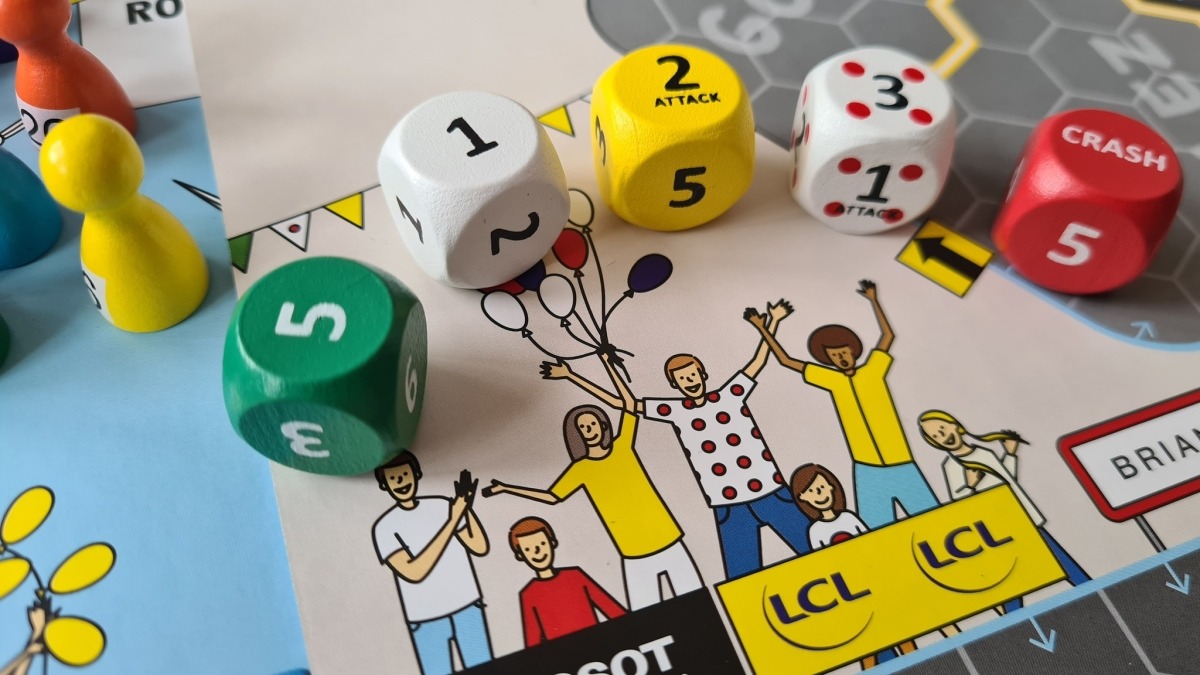About the game - The die is cast
Dice. They're thrown. Only one at a time. If a number with the „Attack“ sign is rolled, sometimes a second one can be rolled. And sometimes none. Are you curious why? Let's explain it!
Just as the cyclist's legs set in motion the bicycle, the dice set our game in motion. There are five of them. Sometimes you can choose which one to throw. Other times you have no choice. Sometimes it's better not to throw, sometimes it would have been better not to throw. The dice bring an element of gambling luck to our game and equally balanced risk.
The yellow die (2/ATTACK-3-3-4-5-6)
This is the basic die of the game, and outside of the hilly sections, you can roll it whenever it‘s your turn. It is missing the number 1, the number 2 brings the possibility of an attack, twice you will find the number 3 on it, once each the numbers 4-5-6.
The green die (3-4-4-5-5-6)
If you've ever heard of the Tour de France, you'll know that green is reserved for the fastest sprinters. In our game it also symbolizes speed / acceleration, so you will find the numbers 3, 2x 4, 2x 5 and once 6 on it. You are only allowed to use it as a second die after you roll the number marked Attack on the yellow or polka dot die and you are in a position to execute an attack.
The polka dot die (1/ATTACK-2-2-3-3-4)
Again, the colouring is not random, the red and white dice is a climber dice, just like in the Tour. You always have to use it in a hill section. In hills it's a real slog and bicycle rides slower, so on the dice you'll find lower number - 1 with the option to execute an attack, then 2x 2, 2x 3 and one 4.
The white die (1-1-2-2-3-3)
The white die can be used only on flat ground, whenever you decide to play tactically to slow down the peloton behind you. It carries numbers 1, 2 and 3, all of them twice.
The red die (4-5-6-7-CRASH-BIG CRASH)
The red die means risk. It can help you to catch up your loss or escape your rivals because it allows you to go as fast as possible. It carries the numbers 4, 5, 6, 7. But, just like higher speed on a bike, you're at higher risk of crashing. A small one, that slows you down for one turn (Crash), or a big one that knocks your pawn out of the game (Big Crash). You can't go fast in the hills, so you can only use it in flat ground sections.
If you read carefully at the beginning, you noticed the information that you don't always have to roll the die in order to move your pawn. If you are riding in a group of riders (other pawns whose fields touch), you can take over the previous player's roll, i.e. speed. This is especially advantageous if he managed to roll a high or highest number. So if you don't want to tactically slow down the peloton behind you, or risk you throw a lower number and thus slow down your rider, you can keep the speed of prevoius player, just like i tis easier for you to keep the speed of biker in front of you. This option is available to all pawns riding in one group. If your pawn is first in new group, you have to throw the dice and set the basic speed for the group you are leading.

